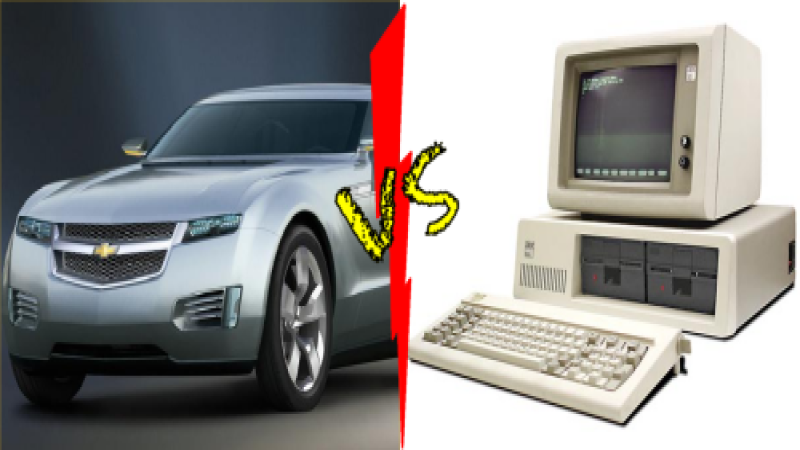Lately, the Chevy Volt has been a kicking can with people on both sides of the argument taking punts at the car, its maker, and the politics surrounding it. Former VP Bot Lutz has ardently defended the Volt while pundits of various stripes have attacked it. Quite often, the argument that today's electric cars are “like computers in the 1980s” is given to justify their high price.
Except EVs are not like PCs at all. They're only similar on the thin surface, but underneath the veneer, they're apples and oranges.
The PC's Early Days
In the early days of computing, pioneers like Bill Gates (love him or hate him), Andy Grove and others were literally working in their garages on what were some of the most sophisticated electronics gadgets ever conceived. The earliest computers, developed during the Second World War to decode enemy transmissions, were room-filling machines that took hours to do what your average cell phone does in milliseconds today. In forty years' time, during the 1980s, computers had shrunk to the point where they were viable in an office setting. The trouble is, the software that runs them (their brains) was nowhere near that level.
Entrepreneurs like Gates, Grove, and Jobs saw this as an opportunity and worked to fill the niche. In those days, buyers of computers were mostly large businesses, usually those having a lot to do with accounting or banking, and most computers were sold through big suppliers like IBM. Computers were extremely expensive, very slow, and generally unwieldy.
Of course, that quickly changed. As more and more computers became available, their prices dropped significantly. Economies of scale and outsourcing of supply for parts and the building of the PC made them become cheaper to make. Software, however, had to keep up and in order for computers to become mainstream, they had to appeal to the Average American, not Big Corp. Gates and Jobs knew this instinctively and focused themselves on making that transition.
Several things make the difference between the PCs in those early days and the EV of today.
The Early Days of the EV
Electric vehicle technology has been around for a long time, but has only recently become something talked about in the mainstream. A decade ago, electrics were an oddity and garage tinkerer's weekend project. Today, they're being made by major automobile manufacturers like Chevrolet, Nissan, and Ford. Yet they're still in their early development and are not likely to become mainstream for decades yet. Despite what proponents of them will tell you.
Electrics have several things holding them back and still must be addressed before the EV will become the car in many people's driveways. The first is marketability, the next is cost, and the third is politics. Each of these is as important as the last. The PC overcame these issues relatively easily, but it took more than a decade to happen. Marketability and cost were closely intertwined while politics were almost a non-issue to begin with.
Marketability
Like the PC, the EV must overcome significant market obstacles over and above cost. Currently, electric cars are only marginally being accepted by the market and make up such a tiny percentage of vehicle sales overall that the EV is still insignificant.
The largest obstacles to the marketability of EVs are batteries and costs. Batteries are, by far, the biggest cost in a pure electric car like the Leaf and are not insignificant in range-extended and hybrid vehicles like the Volt and the Prius. Batteries have a finite lifespan of usefulness and make up a large enough percentage of the car's total cost that depreciation is a serious problem.
So far, there are not enough EVs on the market to reliably find cost-depreciation numbers for the battery's lifespan. The Prius, until recently, had a relatively small battery and so was depreciated like nearly all other standard internal combustion autos have been – by mileage and age. For a battery electric car, though, age means little. Number of charges is what's important. The more often a lithium-ion (the battery type of choice amongst EVs) is recharged and discharged, the less life it will have. An electric's battery is considered to have lost its lifespan when it can no longer hold more than 80% of its original capacity.
For nearly all electric cars, this happens in 7-10 years. Or at about 84,000 to 112,000 miles for the average person driving 12,000 miles per year. Currently, internal combustion vehicles can expect nearly twice that before engine problems become a serious issue. The battery in an EV and the engine in an ICE are roughly equivalent in terms of total cost as a percentage of the vehicle. So replacing the batteries in an EV would cost roughly the same as replacing the engine in an ICE.
Another problem is expected range versus real life ranges. Called “range anxiety” by those in the industry, this problem is one of concern for many people. The good news is that the younger generations are not as prone to this as are older folks in most surveys. Still, a car that goes about 100 miles and then requires hours to recharge is going to be secondary to a car that goes 300 miles and requires ten minutes to refill for another 300 miles. Until charging technology catches up with refills at the pump, this will remain an issue. Technology is working to catch up, but it will, again, take years for it to do so.
Costs
Costs are not insignificant in the sales of EVs versus their gasoline and diesel counterparts. For now, EVs are very expensive and, as stated above, will remain so for some time. The Volt, for instance, has the cost of an entry-level luxury sedan and the usefulness of a compact (in terms of seating and storage). Like it or not, the Volt is mainly sold purely on its green credentials, not on its usefulness to the average driver. Individual Volt owners will no doubt contest this, but in terms of the real-world market, it's a big stumbling block for the car.
The Leaf, by comparison, is sold as a compact and has what compact car owners expect. It does not, however, have much range and is still at the high-end of c-segment MSRPs.
Politics
Finally, we come to politics. This is where the comparison between the PC in its early days and the EV of today fall completely flat. At no time in its early history did the PC have anywhere near the same government incentivization and investment that electric cars do today. In fact, nearly all of the major innovations in personal computing came about due to market trends and needs, in a real-world “innovate or die” scenario – the single most important incentive to private enterprise.
Sure, early PC adopters included government, but that was government that acted, for the most part, as a consumer, not a direct investor via incentives. The electric car? Not so much.
Government is heavily vested in electrics from top to bottom. The Chevy Volt, for instance, received $240 million in Department of Energy grants, a $14 billion retooling loan for GM factories (not all of which, I admit, went to the Volt), and $150 million in stimulus grants to the original battery maker – located in Korea – for the car. That's over and above other incentives and stimulus such as the $50 billion in bailouts GM received, the $1.5 billion in possible consumer incentives given with the federal tax credit for purchasing a plug-in, etc.
Then there are state-level incentives for producing or purchasing a high-cost EV – the state with the biggest handouts likely being California, whose CARB and other entities give huge grants. All of these incentives add up to mean that the cost of the car itself is less than it would be were it purely a product of the market.
Is this a good thing? Or does this kind of incentivization mean that other, better technologies are likely being ignored in favor of the flavor of the day?
Therein lies the problem. If government enters the market as an investing force, not a consumer, it becomes a hand that guides the market itself. Given the record of government in doing much of anything well, with the notable exceptions of warfare and taxation, this does not look good for markets as a whole.
If one of the biggest incentives to building the car of the future is what kind of government money you can get for doing so, then obviously the “car of the future” is going to be whatever bureaucrats handing out grants and subsidies say it's going to be.
That does not lead to innovation. It leads to stagnation. So if the Volt is “the most technologically advanced car on the planet,” as Lutz put it, then it's as good as we're going to get because it's the best car that subsidies can buy.
I believe that electric cars have a place in our automotive future, but I do not think they'll be the only technology running. They are great for some situations and good for others, but other technologies also have a place in tomorrow's transportation. Sadly, those technologies might be largely marginalized thanks to the over-focus on EVs.












Comments
Kudos. Thanks for bringing
Permalink
Kudos. Thanks for bringing this issue into focus, as that has to be one of the more coherent and balanced articles I've read lately. Among the many green-only-at-any-cost politico statements floating around, this is a great comparison between PC and EV with regard to incentives. Just so the PC heads don't get too big, though, may I add that a PC never had to function between -50 deg F to 120 deg F.
Ya, but an EV will never
Permalink
In reply to Kudos. Thanks for bringing by Frank Sherosky
Ya, but an EV will never likely be asked to delve into and correctly interpret IRS tax code. :)
I agree; finally an article
Permalink
In reply to Kudos. Thanks for bringing by Frank Sherosky
I agree; finally an article that isn't just Volt bashing but a sensible analysis of the issues. I'm intrigued by the Volt but wonder about sub-zero battery life and no engine heat for the first 40 miles! Here in the upper Midwest people own boats, campers, snowmobiles, ATVs, and horses - which electric beer can is going to pull those down the road? Why don't light trucks and SUVs have 4 and 6 cylinder turbo diesels in them? The author is on to something - what other technologies are we neglecting to subsidize and rush hybrids and pure electrics to market? Make hybrids more practical and affordable, make them appealing and able to do the things we need our cars and trucks to do, and people will buy them. Especially when the government does nothing to prevent $4-5/gallon gasoline. Oh yeah, government - rather than investing our tax dollars into speculative technologies, how about investing in domestic energy production? Hybrids and EVs will inevitably come some day, but for now pick the low hanging fruit - domestic oil production and continued refinement of efficient gas engines and clean diesels.
Thanks and good points. It's
Permalink
In reply to I agree; finally an article by Anonymous (not verified)
Thanks and good points. It's interesting to note that hybrid pickup trucks (I covered those yesterday, all made by GM) are getting lower mileage numbers than the equivalent turbodiesel option. A lot of this has to do with energy density and the differences in how that energy is captured in a gasoline vs. diesel engine.
I also live in the Midwest (eastern Wyoming) and know that electrics do not generally do well in our winter climate. In the little town I live in, golf carts are a favorite get-around vehicle for many people. In the winter, they are stored with their batteries removed and kept under climate control to prevent problems.
Great comparison an debunk.
Permalink
Great comparison an debunk. It is good to see an alt vehicle guy that is not hooked on electrics.